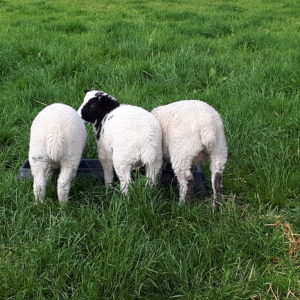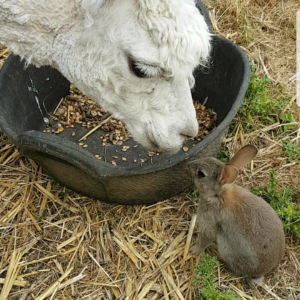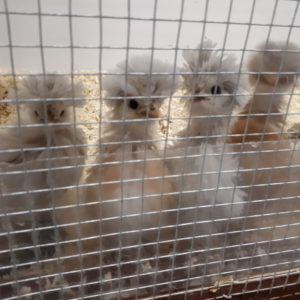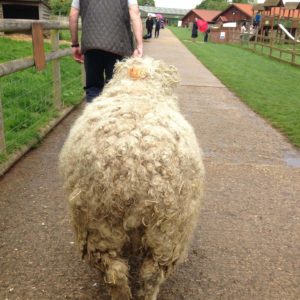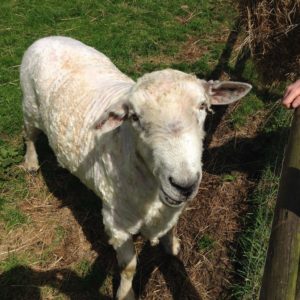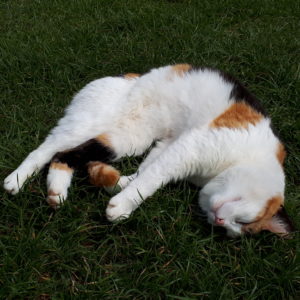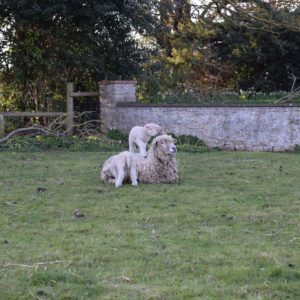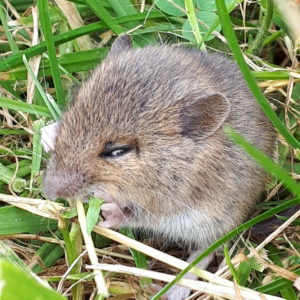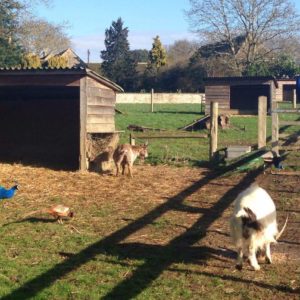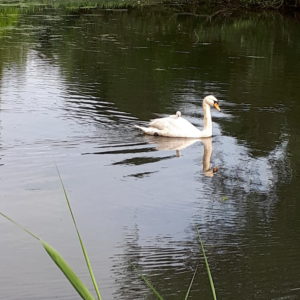-
How do you like your eggs in the morning?
If you’ve visited the farm recently, you may have noticed that the Discovery Centre is looking a little quiet. There will be some changes in the animal village over the next few months, and some of our smaller, furrier animals will be going to retirement homes. However, we’re really excited to announce that we will be using this space to develop our hatchery.
At the moment, we have one incubator. This keeps the eggs at the right temperature (37.5°C for chicken eggs) and keeps the air moist enough (around 50%) so that any fertile eggs should hatch in around 21 days. Our incubator can also roll the eggs, which replicates the way that the mother hen would naturally turn her eggs on a regular basis.
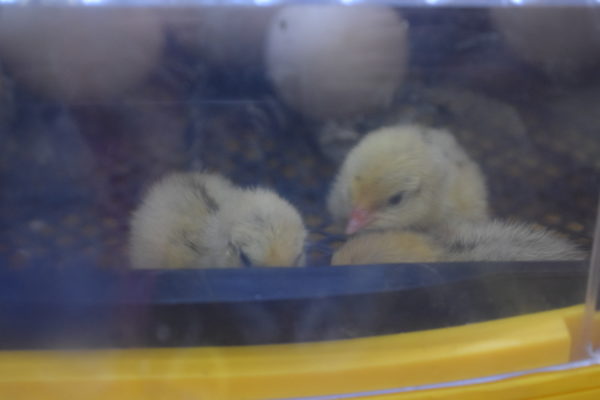
If you are very lucky, you might see some chicks hatching in the incubator whilst visiting Sacrewell. The chicks need to stay in the incubator until they are dry and fluffy, so although our team check on the eggs each morning and night, there’s no need for urgent action during the hatching process. The chick can actually survive up to 24 hours after hatching before it needs to have any food or water.
With the development of the hatchery, we can have chicks and ducklings all year round. From polish bantam chickens to quails to New Hampshire reds, there will be more feathered friends at the farm when you visit next.
If you’ve thought about keeping chickens, ducks or other type of poultry then watch this space.
-
Do you have any sheepdogs at Sacrewell and if so, how do you train them?
Each week, we ask you to share your questions about farming, food or Sacrewell with us on Facebook. The person who writes the best question wins a free tractor ride for a child and accompanying adult, as well as having their question answered on our website. This question came from Gemma Hutchison’s son Dominic.
We don’t have any sheep dogs that belong to Sacrewell, though all well behaved dogs on leads are welcome to visit the farm and quite a few of our staff have their own dogs at home.
However, we’re excited to announce that, for one day only, the Dog and Duck show is coming to Sacrewell as part of our Harvest Weekends. On Sunday 10th September you can watch and learn how the dogs in the show are trained to herd ducks around the paddock, using the same skills that they would use to herd sheep in much larger areas.
Here’s a little taster of what the show involves:
-
What happens to all of the eggs that your chickens lay?
Each week, we ask you to share your questions about farming, food or Sacrewell with us on Facebook. The person who writes the best question wins a free tractor ride for a child and accompanying adult, as well as having their question answered on our website. This question came from Jo Binge’s son Ross.
There’s a lot of eggs laid at Sacrewell farm, with our flocks of hybrid hens and New Hampshire Reds in their outdoor enclosures as well as the Bantams and quails (which are not chickens but do lay eggs) who live in the Discovery Centre, so it’s no wonder that our visitors would like to know what happens to them.
Our animal team collect the eggs on a daily basis and most of them are then taken to Reception where they are boxed up and labelled, ready for sale to our visitors. Depending on the time of year, we usually fill around a box and a half each day. The number of eggs varies as each individual hen can lay less when there are fewer daylight hours, when she is moulting or if she has been stressed by any changes in her environment.
Occasionally, we decide to hatch some of our eggs. When this is the case, we place the eggs in our incubator which you can find in the Discovery Centre. The incubator keeps the eggs at the right temperature (37.5°C for chicken eggs) and keeps the air moist enough (around 50%) so that any fertile eggs should hatch in around 21 days. Our incubator can also roll the eggs, which replicates the way that the mother hen would naturally turn her eggs on a regular basis.
If you are very lucky, you might see some chicks hatching in the incubator whilst visiting Sacrewell. The chicks need to stay in the incubator until they are dry and fluffy, so although our team check on the eggs each morning and night, there’s no need for urgent action during the hatching process. The chick can actually survive up to 24 hours after hatching before it needs to have any food or water.

There is one more way that the eggs are used at Sacrewell farm, which involves special groups like our Sacrewell Seedlings club. These lucky toddlers spent one session learning about the chickens, during which they collected eggs from the chicken enclosure and then watched them being fried before tasting them on some lovely floury baps. From field to fork (or in this case, fingers) in less than an hour and a half!
References
-
How do the animals keep cool when it’s hot?
Each week, we ask you to share your questions about farming, food or Sacrewell with us on Facebook. The person who writes the best question wins a free tractor ride for a child and accompanying adult, as well as having their question answered on our website. This question came from Nevaeh who is aged 6.
The main way that our animals keep cool when it’s hot is to seek out shade, so it’s important for us to make sure that there are shady areas available in each animal enclosure on the farm. On a sunny day you might notice the sheep and goats sticking close to the walls of their wooden shelters, which provide shade, or the rabbits hiding in the patch of shade directly underneath their hutches.
 When humans get hot, we cool down by sweating. The sweat we produce is mostly water and when the water evaporates from the surface of our skin, we can lose some heat energy and cool down. Some animals, like horses, also produce sweat to help them keep cool when it’s hot.
When humans get hot, we cool down by sweating. The sweat we produce is mostly water and when the water evaporates from the surface of our skin, we can lose some heat energy and cool down. Some animals, like horses, also produce sweat to help them keep cool when it’s hot.Pigs, however, don’t sweat. On a hot sunny day, they like to roll in mud to keep themselves cool instead. This works in a similar way because as the water in the mud evaporates, the pigs can lose some heat energy and cool down. The mud can also act as a protective layer against the UV rays from the sun, preventing pigs from getting sunburnt, and it can help to remove some parasites.
Chickens also don’t sweat and are much
 better at coping with cold weather than hot weather. They can lose some heat energy through their comb and wattle (that’s the strange wobbly bits you find on their heads and on their necks) as well as through their feet. You might also see them panting on a very hot day. When they pant, they push hot air out of their bodies and draw in cooler air from the outside.
better at coping with cold weather than hot weather. They can lose some heat energy through their comb and wattle (that’s the strange wobbly bits you find on their heads and on their necks) as well as through their feet. You might also see them panting on a very hot day. When they pant, they push hot air out of their bodies and draw in cooler air from the outside.Another creature which has evolved to cope better with cold than heat is the rabbit, with its wonderful furry coat. As we’ve already mentioned, our rabbits seek out shade when the sun comes out. They can lose some heat through the blood vessels in their ears as these are not covered in fur.
The key to keeping all of our farm animals cool on a hot summer’s day is providing them with shade and water so that they can stay hydrated. We try to do the same for the humans on the farm too!
References
-
How many boxes of cereal would an average wheat field make?
Each week, we ask you to share your questions about farming, food or Sacrewell with us on Facebook. The person who writes the best question wins a free tractor ride for a child and accompanying adult, as well as having their question answered on our website. This question came from Bella and Theo Oxenbould:
We know a bit about wheat at Sacrewell. We know that in a one square metre field, you can plant 250 wheat seeds, which will grow and produce 1 kilogram of wheat grain. So that was our starting point.
Then we went to find out about some cereal. The nice people at Weetabix told us that they use 365 grains of wheat to produce just one Weetabix biscuit. Their biscuits come in a variety of box sizes, but we sell the small, 24 biscuit pack in the campers section of our shop, so we’re going to concentrate on that one.
If you prefer cornflakes to Weetabix, you might be interested to know that they are made from maize (aka sweetcorn) rather than wheat (aka corn). We haven’t done the calculations for a field of sweetcorn, but we did find this great episode of Food Unwrapped which shows how the sweetcorn is made into cornflakes in a factory.
Then it was time to do some maths.
The average field in the UK is 12 hectares:
12 hectares = 12 000 square metres.
1 square metre produces 1kg of wheat grain, so 12 000 square metres produce 12 000 kg of wheat grain.
1 kg of wheat contains approximately 25 000 grains of wheat:
25 000 x 12 000 = 300 000 000
So we get 300 000 000 grains of wheat from an average field, and it takes 365 grains to make each Weetabix biscuit.

300 000 000 ÷ 365 = 821 918 biscuits
There are 24 biscuits in a small box.
821 918 ÷ 24 = 34 246 boxes.
We’ve made quite a lot of estimates and assumptions in our calculations. The weight of an individual wheat grain can vary depending on the variety and how well it grows. The yield of grain from a field can vary depending on the weather and soil conditions that it was grown in. The size of an actual field can vary hugely.
But we’re happy to say that an average wheat field would make approximately 34 thousand small boxes of Weetabix cereal. That’s more than enough for me to have two in my breakfast bowl every day for the next 46 years!
References:
http://www.nebiodiversity.org.uk/
https://www.reference.com/food/many-grains-wheat-gram-88a4bf0a5a8ebff3
Images from www.pixabay.com
-
What’s your monthly animal food bill?
Each week, we ask you to share your questions about farming, food or Sacrewell with us on Facebook. The person who writes the best question wins a free tractor ride for a child and accompanying adult, as well as having their question answered on our website. This week, they’ve won a family day pass and the question came from Susan Wallwork’s eight year old daughter Abigail.
There are lots of different mouths to feed on the farm, and every one has their own special diet. Most of our animals stay outdoors and will graze the grass, legumes and other pasture plants found in their paddocks.
Each animal also has their own specific dry food, which for the larger animals is usually a grain mixture consisting of corn, oats, barley as well as added minerals and vitamins. We call this the hard feed order (including the pet yard animals) and it’s about £150 / week.
When you walk down the path, you will probably see the metal baskets filled with hay (or more likely, an empty basket with hay all over the floor after the goats and sheep have eaten their breakfast). We buy the hay (for feed) and straw (for bedding) together and this is around £200 / week.
In addition to this are any special dietary needs: –
Donkeys have Farrier Formula for hoof growth at £37 per 5kg and anti-bacterial hoof treatment
Calves are still on powdered formula milk at nearly £40 per 20kg bag and calf creep pellets.They also get treats like fresh fruit and veg (watch our donkeys get some turnip treats is this farm camp video from 13:50) from time to time.
This means our monthly food bill alone is around £1200, and on top of this the animals all require regular vaccinations, wormers and sometimes antibiotics plus fly treatments (mainly for sheep and horses) and anything we can’t diagnose or treat on site will require a vet visit.
Sacrewell is run as a charity by the William Scott Abbott Trust with the aim of providing an agricultural education for everyone, from school children to heritage enthusiasts. As a charity, we are always happy to receive support and donations are welcome. You can help us to educate and delight future generations by becoming a member or volunteering on the farm.
-
The first ever Farm Camp at Sacrewell
A recent study of four-to-eight year olds in London found that one-third of them didn’t know that milk was produced by cows. Sacrewell and the William Scott Abbott Trust are on a quest to change statistics like these through their new Farm Camp programme. The programme offers school groups the opportunity to fully immerse themselves in farm life, from mucking out the donkeys to digging up the potatoes they’ll eat for dinner, developing life skills like team work and resilience along the way. Groups will also spend at least one night under canvas on the farm, sleeping in the peace and quiet of rural Cambridgeshire until the resident peacocks wake them up with their morning alarm call.
The programme was officially launched on July 13th and 14th with a camp for the Year 3 children and staff from Ravensthorpe Primary School in Peterborough. Martin Fry, the head teacher said, “We’ve had a fantastic time. One of the highlights for me was seeing the children make their own apple juice with the apples and the apple press. It was great seeing that whole process of where we get the things that normally we just find in the supermarket. The children were really into that.” The eight year old pupils also enjoyed their visit, Cara said “I enjoyed the campfire,” and Bradley said the pizza that he made from scratch was “Delicious!”

This exciting programme has been made possible with £21,240 of funding from Mick George Limited through their Mick George Community Fund. Nikki Cherry, Engagement Manager for Learning at Sacrewell is pleased with the success of the first farm camp and very grateful for the support she has had from the team of staff and volunteers at Sacrewell. She hopes that many more children will benefit from a Farm Camp experience in future.
After the success of this pilot camp, Sacrewell are taking bookings for school groups who wish to give their pupils an insight into farming and where their food comes from, combined with a residential stay. Farm Camp will be available from May to October 2018, please see our Learning pages for more details of our schools offer.
-
What do the peacocks eat?
Each week, we ask you to share your questions about farming, food or Sacrewell with us on Facebook. The person who writes the best question wins a free tractor ride for a child and accompanying adult, as well as having their question answered on our website. This question came from Emma Mehmed’s three year old son.
The peacocks at Sacrewell are free to roam wherever they like on the farm so they are opportunistic feeders. They can often be seen lurking near the picnic tables outside the mill, waiting for a family picnic to finish so they can enjoy the crumbs that have been left behind. They can also easily hop over the fences in our animal paddocks and have been known to nibble on the seed and cereal mixes that we feed to our goats and sheep.
Peafowl (the term used for both male peacocks and female peahens) are not a native British species. The blue ones which you can see at Sacrewell originally come from India and Sri Lanka. There are also green peacocks from Java and Myanmar and a third, lesser-known species called the Congo peacock which has a range of coloured feathers.
In the wild, peafowl forage for plants, insects and small creatures which they can find on the ground. They are omnivores, which means that they eat both plants and animals. The peacocks at Sacrewell forage around the farm in the same way. They’ll find plenty of plants and insects in the hedgerows that line our paths and paddocks.
Although the Sacrewell peacocks are happy to take advantage of an easy meal, it is much healthier for them to move around and search for food in a natural way. We would ask our visitors to remember this when they are having their picnics and ensure that any rubbish or leftover food gets safely stored inside our wheelie bins.
References
http://www.nationalgeographic.com/animals/birds/group/peacocks/
http://www.arkive.org/congo-peafowl/afropavo-congensis/image-G19975.html
-
Which animals are the most photogenic?
Each week, we ask you to share your questions about farming, food or Sacrewell with us on Facebook. The person who writes the best question wins a free tractor ride for a child and accompanying adult, as well as having their question answered on our website. This question came from Pati Patka Aparatka.
Working at the farm every day, we get to see witness some incredible things yet rarely have a camera at the ready. Yesterday, we watched a calf have the surprise of its life as it investigated some grass and got its poor nose stung by a nettle. For the first time in the spring I watched a ewe give birth. I blinked, and out popped lamb number two.
Some moments are hilarious, others are breath taking and it’s really hard to be able to point out the most photogenic animals because it is absolutely down to luck. Instead, enjoy a selection of our favourite shots of the animals since the new year. Thanks to Jill, Oli, Amy and Harriet for the photos.
Feel free to share your snaps with us on our Instagram, we share the best ones in our newspaper Sacrewell in Season.
- Three wise lambs
- Date night at Sacrewell
- The Bantam Chick Rockstars
- Keith the Lincoln Longwool (before)
- Keith braving the shave
- Rosie the farm cat stretching
- Mums don’t get a break
- Farm taxi service
- Field mouse eating
- Monday morning debrief
- Cygnets hitching a ride on mums back
-
What are peacock babies called?
Each week, we ask you to share your questions about farming, food or Sacrewell with us on Facebook. The person who writes the best question wins a free tractor ride for a child and accompanying adult, as well as having their question answered on our website. This question came from Kate Baker’s son.
Peacock babies are called peachicks, though you won’t find any peachicks at Sacrewell as we only have male peacocks and no peahens.
We thought you might be interested to know the correct terms for the male, the female and the baby of some other animals that we have on the farm too.
Animal Adult male Adult female Young peafowl peacock peahen peachick pig boar sow piglet cattle bull cow calf chicken cockerel hen chick sheep ram ewe lamb goat billy nanny kid horse or pony stallion mare foal alpaca macho hembra cria donkey jack jenny foal guinea pig boar sow pup rabbit buck doe kit For some animals, farmers also use different words for adult animals which are used for breeding and adult animals which aren’t. Here are two examples:
Animal Castrated male Breeding male Young female Breeding female pig barrow boar gilt sow cattle steer bull heifer cow 
An adult male peacock displaying his fabulous feathers.
-
A new fitness regime for our ponies and donkeys
The equine animals at Sacrewell have been a little bit spoiled in the past, but our Farm Assistant Amy has now taken their care in hand and, with advice from our vet and the Donkey Sanctuary, she’s given them a new fitness regime.
Overweight animals, like overweight humans, can be susceptible to long term health problems such as heart and lung conditions. Equine animals (horses, ponies, donkeys and zebras) which are overweight also become more susceptible to a condition called laminitis.
Laminitis is defined by World Horse Welfare as “a condition of the feet in which there is painful inflammation and weakening of the sensitive tissues (laminae) that bond the pedal bone (the main bone within the hoof) to the hoof wall.” It can cause extreme pain and makes it difficult for the animals to walk.
Our Shetland pony Tramp has had laminitis in the past, which means it is likely to come back again, so Amy has been taking special steps with him and Luna. It’s a two pronged attack involving a gradual restriction of their diet and a gradual increase in their exercise. They are now being taken for a daily walk around the farm, before which, if she has time, Amy gives the ponies a thorough grooming. This helps their circulation and warms up their muscles. You might also notice, if you’re a regular visitor, that the ponies are spending more time in the stables than in the paddock, as their access to the rich Cambridgeshire grass needs to be restricted. Amy is hoping to buy some small holed hay nets in the future so the ponies can have the constant access to food that their digestive system requires, but without the risk of them gorging themselves.
Donkeys can also suffer from laminitis, so there have been changes in the donkey paddock too. The animal team have set up a series of fences in what is known as a ‘paradise paddock’. By placing the food, water and shelter that the donkeys need at different points in the maze of fences, we can encourage them to get more exercise throughout the day. This system also provides the donkeys with mental stimulation as the fences can be moved from time to time to create a new, more challenging maze.
The donkeys haven’t been able to try their new paddock yet as Jolly Joules is under vet care for a foot injury and needs to stay in the stable. In the meantime, Amy has come up with healthy ways to keep them entertained such as tasty tree branches to nibble on and dingley dangley treats.
References:
-
Peter the Rabbit (Belgian Hare)
Most of you should recognize this beautiful Belgian Hare from the animal village. Peter, loved by many, passed away peacefully in his sleep last week. He loved having his long ears stroked and had a rather inquisitive character.
Despite the name, Belgian Hares are a type of domestic rabbit. Selectively bred to look like a wild hare, these rabbits were imported from Belgium to Britain in 1874. They have long slender body and agile legs, just like the hares you see in the countryside. The Belgian Hare is one of the most intelligent and energetic of rabbit breeds.
Peter will be missed by our volunteers, staff and visitors.

Peter the Belgian Hare
